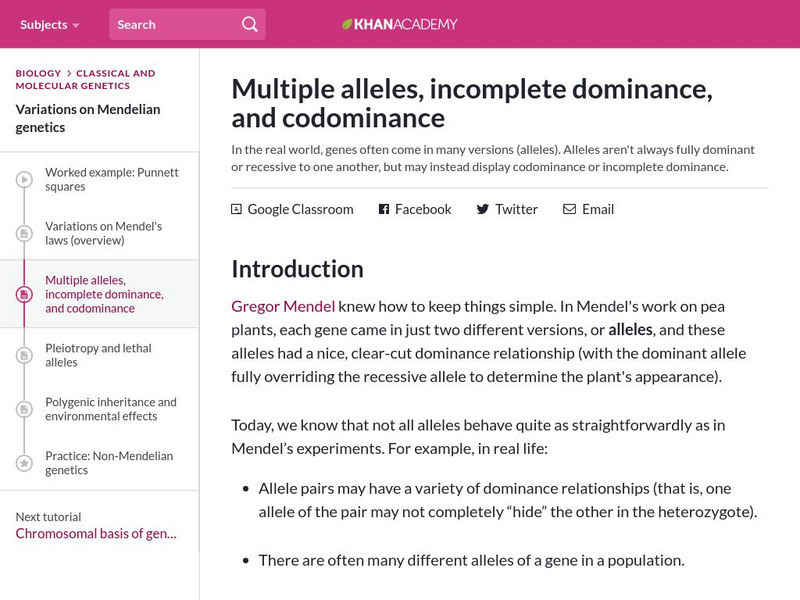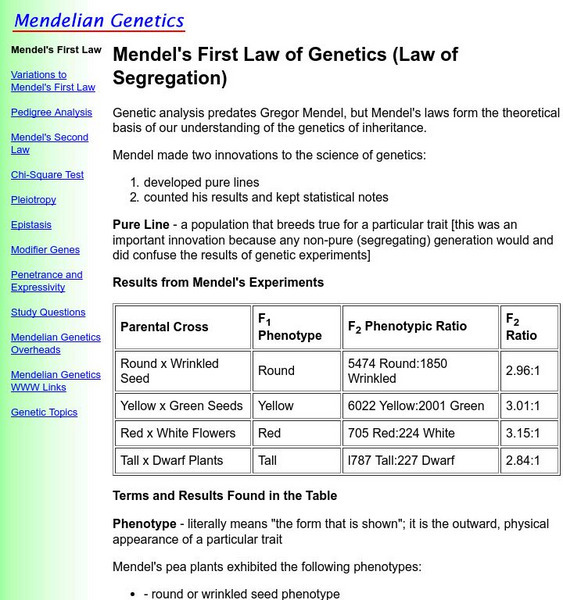Hi, what do you want to do?
Curated OER
The Genetic Basis of Neurological Disorders
Young scholars describe some aspects of known genetic defects on the human neurological condition. They participate in a variety of exercises including drawings, games, and analogies.
Curated OER
Human Inheritance
Pupils analyze genetic characteristics in a given family tree through the F2 generation. Students apply prior knowledge from Gregor Mendel's study with pea plants and his Laws of Heredity to answer questions.
Curated OER
Blood Business
Students identify the different kinds of blood. In this biology lesson, students investigate the antigens, agglutinins and Rh factor using their own blood. They use Punnett squares to predict blood type of offspring.
Curated OER
Online Research for a Genetic Disorder
For this genetics worksheet, learners access a given website, chose a genetic disorder, and complete the 10 short answer questions about the disorder.
Curated OER
Karyotypes & Chromosome Inheritance
Students study Mendelian genetic terms, locate and name loci on chromosomes, karyotype construction, inheritance patterns through families.
Curated OER
Human Genetics
This is a worksheet regarding human genetics where students can poll the class regarding specific traits.
Curated OER
EMS Lesson 2: Outrageous Offspring
Students investigate the principles of probability that can be used to predict hereditary traits.
Curated OER
Nature vs. Nurture
Eighth graders investigate the concept of nature versus nurture in human development through this series of lessons.
Curated OER
Inheritance Word Search Puzzle
In this literacy instructional activity, students find the words that are related to the concept that is the theme of the word search puzzle.
ArtsNow
Arts Now Learning: The Gene Connection Show [Pdf]
Fifth graders will discover the difference between inherited traits and learned behaviors by bringing the traits to life in a game of charades. After that, the students will demonstrate knowledge of recessive and dominant traits as they...
Vision Learning
Visionlearning: Genetics: Gene Expression
Explore the connection of genes and enzymes in regards to heredity and genetics. Concepts associated with dominant and recessive traits are also presented.
University of Hamburg
University of Hamburg: Deviations From Mendelian Laws And: What Is the Meaning of Dominance?
Upper level discussion of several of Mendel's experiments and laws.
The Association of the British Pharmaceutical Industry
Abpi: Genes and Inheritance
A complete, student-paced lesson on genetics and inheritance. Students work their way through illustrations and animated tutorials, and answer review questions along the way. There is a self-checking quiz at the end of the lesson.
BiologyWise
Biology Wise: Dominant and Recessive Traits in Humans
Explains what dominant and recessive traits are and how they work, and provides a list of single gene traits with the degree of manifestation if they are dominant or recessive. Also discusses co-dominance, incomplete dominance, polygenic...
Center for Innovation in Engineering and Science Education, Stevens Institute of Technology
Ciese: Human Genetics Project: Is the Dominant Trait Most Prevalent?
Human-Genetics: A Worldwide Search for the Dominant Trait allows you to collect data and share your results with students around the world. Register your class, complete the student survey, participate in discussion boards, and interact...
PBS
Pbs Learning Media: Some Genes Are Dominant
This interactive activity, adapted from the Dolan DNA Learning Center, illustrates how Gregor Mendel used purebred yellow and green peas to show that some genes are dominant and others are recessive.
Khan Academy
Khan Academy: Multiple Alleles, Incomplete Dominance, and Codominance
In the real world, genes often come in many versions (alleles). Alleles aren't always fully dominant or recessive to one another, but may instead display codominance or incomplete dominance.
National Cancer Institute at the National Institutes of Health
National Cancer Institute: What Are Gene Mutations?
This website provides an answer to the following question: "What are Gene Mutations?" Many links are provided throughout this short description that access information on related subjects.
TeachEngineering
Teach Engineering: What's Dominant?
In a class discussion format, the teacher presents background information about basic human genetics. The number of chromosomes in both body cells and egg and sperm cells is covered, as well as the concept of dominant and recessive...
Oklahoma State University
Oklahoma State University: Ag in the Classroom: Hairy Heredity [Pdf]
A simulation where students flip coins to mimic how parents pass genetic traits to their offspring through heredity. This activity also illustrates the difference between dominant and recessive genes, and how they interact with each...
Cold Spring Harbor Laboratory
Dna From the Beginning: Classical Genetics
This article from DNA from the beginning is loaded with goodies about genetics and DNA. Starting with Mendel all the way through the concept of DNA, you will see how life is given certain characteristics. Some animations and audio clips...
TeachEngineering
Teach Engineering: The Benefits of Biodiversity
First, students toss coins to determine what traits a set of mouse parents possess, such as fur color, body size, heat tolerance, and running speed. Next they use coin tossing to determine the traits a mouse pup born to these parents...
Palomar Community College District
Palomar College: Practice Quiz for Mendelian Genetics
This site from Palomar College provides an online practice quiz includes history as well as some of the genetics. Includes feedback. A great learning and practice site.
Other
North Dakota State: Mendel's First Law (Law of Segregation)
This resource explains Mendel's first law (Law of Segregation) in detail. Includes Mendel's original experiments with results and conclusions.














![Arts Now Learning: The Gene Connection Show [Pdf] Lesson Plan Arts Now Learning: The Gene Connection Show [Pdf] Lesson Plan](https://static.lp.lexp.cloud/images/attachment_defaults/resource/large/FPO-knovation.png)








